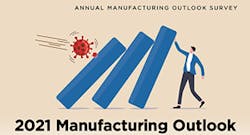Food manufacturers are feeling at least moderately optimistic about their prospects for 2021, according to our annual Manufacturing Outlook Survey.
Asked directly how they view the new year, 21% of our 158 respondents said they were “very optimistic” and another 37% said they were “somewhat optimistic.” Only 13% were pessimistic to any degree, and the remaining 29% said they were neutral or not sure.
Download Your Copy of the Survey Results
The survey had two other questions that can be taken as indicators of optimism. Asked about staffing plans, 41% said their companies plan to add staff, and 44% said they probably will maintain current staffing levels. Asked about what will happen to production levels at their companies, a plurality of 41% said the plan was to increase production by adding lines or plants, while 35% said they will probably stay the same.
This optimism, however moderate, echoes the attitudes of American business as a whole, according to the economic advisory service IBISWorld. Its “business sentiment index,” defined as a gauge for “the overall health of the business environment,” will increase 5.7% in 2021, as consumer confidence improves with an end to the pandemic in sight.
The pandemic, of course, is the overriding concern of pretty much every business and institution. We asked how respondents were coping with it, giving them multiple answers to choose from (more than one if they wanted). The most popular answers were “we had to change production scheduling to meet changes in demand” (59%) and “we make workers stand farther apart on the plant floor” (52%).
Some respondents included comments about the pandemic that were not part of the options provided: “We have to sanitize all the areas every few hours”; “Delays in receiving supplies”; “Tremendous focus on worker education on how to stay safe and healthy”; “Hard to see vendors”; and, simply and sadly, “Fallen morale in workers.”
What’s most important?
We gave respondents a list of 10 manufacturing issues to rank in order of importance. The top four finishers: food safety, cost control, worker safety and changes due to COVID. (The latter two obviously can be conflated.)
Of course, there are more than 10 manufacturing issues facing the industry, so we allowed respondents to specify their own. Here are some of the more interesting ones:
“How to improve training to deal with poor practices and reduced labor available.”
“Less paper, more computer-based tech.”
Survey Results
Our 2021 Manufacturing Survey was conducted in November 2020 and included the responses from more than 150 food and beverage professionals. Download your copy of the survey results to get access to the data.
“Employees quitting early rather than finishing seasonal work because they qualify for unemployment and receive government checks because of COVID-19.”
From someone in Baltimore: “Safety on the grounds immediately outside of our manufacturing facilities due to civil unrest.”
We asked respondents about food safety, their No. 1 issue. Given a choice of options, the most overwhelmingly popular response, at 71%, was employee training. The next most popular ones were “more/improved sanitary equipment” (42%); a HACCP plan (33%); and third-party certification (32%).
Automation is an ongoing issue in food manufacturing, and it’s something we always ask about. One of the biggest issues that arise in automation is hiring people who can handle it.
“I think one of the major reasons why food and beverage have been slow to automate is that they’re having difficulty finding the technical workers needed to design, program and operate automation solutions,” says Tyler Noesser, technical director of Alliantgroup, a provider of specialty tax services.
“It seems counterintuitive because we assume automation will take jobs, but in fact automation ends up creating a demand for technical workers,” he continues. “The fact is, even if a food and beverage company wants to automate, there just is not a large enough pool of technical workers versed in automation.”
We asked respondents to rank 10 strategies for dealing with personnel issues related to automation. Their top three choices (with multiple answers allowed): Expanding in-house technical training, 42%; recruiting maintenance technicians, 33%; adding in-house engineering capabilities, 31%. A quarter said they were “not addressing the issue.”
A couple of respondents alluded to the need for training. One said, “We are seeking a variety of ways to help train and educate students in the field of automation and mechatronics.” Another said, “Working with outside consultants to assess and implement automation and train staff.” One gave the simplest possible explanation for not having to worry about automation: “We’re still making hand-twisted pretzels.”
The digital age
Closely related to automation is the issue of digital technology in general. Of the 10 alternatives we gave, the most popular responses were (with multiples permitted): “Replacing paper records with electronic” (52% of responses); “Replacing analog devices with digital sensors and meters” (38%); “Shifting from local servers to cloud computing” and “Providing more remote access to machine controls” (tied at 35%).
The last option usually has to do with allowing access to equipment manufacturers or other third parties to diagnose problems. One respondent was wary: “Due to cybersecurity risks, less remote access, no OEM access.”
We also asked about maintenance issues. Of a list of 10 strategies to optimize asset use, the most popular response, at 53%, was “On-the-job training programs are being added to expand maintenance workers’ skill sets.” The next most popular were “Routine maintenance duties are being assigned to machine operators” (47%) and “additional maintenance technicians are being hired” (35%).
Capital spending related to manufacturing was another topic. A plurality of 32% didn’t know what their companies’ plans are for 2021. Of the rest, 25% said they expected it to stay about the same, while 27% expected it to go up anywhere from 5% to more than 10%.
We asked respondents to rank what how think their companies will be investing that money. The top three options: process equipment, packaging equipment and plant/worker safety.
We also asked them to mention any capital expenditures that were not on our list. This drew a spate of mentions of specific equipment like blanchers, chillers, dehumidifiers, etc.; several mentioned moving to larger quarters. Some of the more interesting individual responses included: “Installing dust shields over parts of equipment where food is exposed”; “Creating a video ad for trade shows/website”; “Buying cannabis extraction equipment.”
One respondent said simply (echoed by several others): “Most of the big capital projects have been postponed until we see what happens to sales over the coming year.”?



